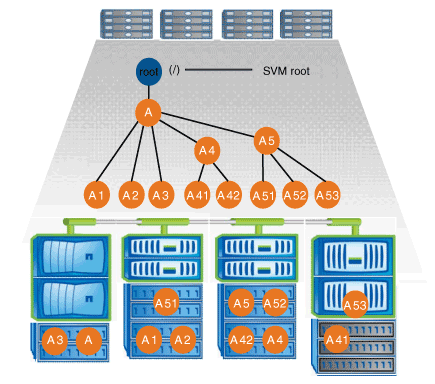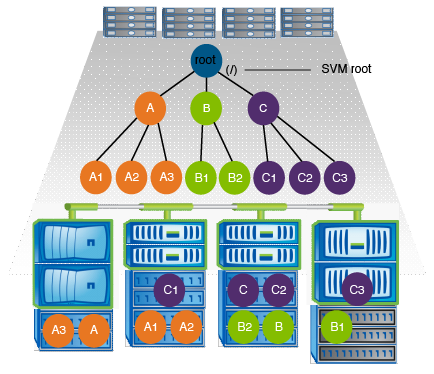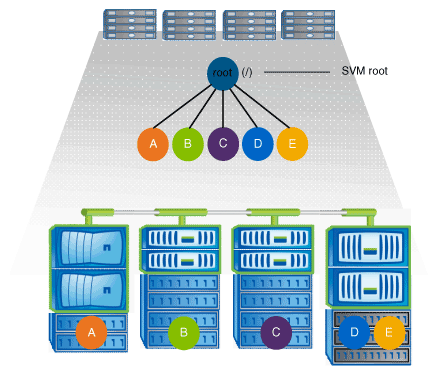Learn about ONTAP NAS namespace architectures
 Suggest changes
Suggest changes


There are several typical NAS namespace architectures that you can use as you create your SVM name space. You can choose the namespace architecture that matches your business and workflow needs.
The top of the namespace is always the root volume, which is represented by a slash (/). The namespace architecture under the root falls into three basic categories:
-
A single branched tree, with only a single junction to the root of the namespace
-
Multiple branched trees, with multiple junction points to the root of the namespace
-
Multiple stand-alone volumes, each with a separate junction point to the root of the name space
Namespace with single branched tree
An architecture with a single branched tree has a single insertion point to the root of the SVM namespace. The single insertion point can be either a junctioned volume or a directory beneath the root. All other volumes are mounted at junction points beneath the single insertion point (which can be a volume or a directory).

For example, a typical volume junction configuration with the above namespace architecture might look like the following configuration, where all volumes are junctioned below the single insertion point, which is a directory named “data”:
Junction Junction Vserver Volume Active Junction Path Path Source ------- ------------ -------- ------------------- ----------- vs1 corp1 true /data/dir1/corp1 RW_volume vs1 corp2 true /data/dir1/corp2 RW_volume vs1 data1 true /data/data1 RW_volume vs1 eng1 true /data/data1/eng1 RW_volume vs1 eng2 true /data/data1/eng2 RW_volume vs1 sales true /data/data1/sales RW_volume vs1 vol1 true /data/vol1 RW_volume vs1 vol2 true /data/vol2 RW_volume vs1 vol3 true /data/vol3 RW_volume vs1 vs1_root - / -
Namespace with multiple branched trees
An architecture with multiple branched trees has multiple insertion points to the root of the SVM namespace. The insertion points can be either junctioned volumes or directories beneath the root. All other volumes are mounted at junction points beneath the insertion points (which can be volumes or directories).

For example, a typical volume junction configuration with the above namespace architecture might look like the following configuration, where there are three insertion points to the root volume of the SVM. Two insertion points are directories named “data” and “projects”. One insertion point is a junctioned volume named “audit”:
Junction Junction Vserver Volume Active Junction Path Path Source ------- ------------ -------- ------------------- ----------- vs1 audit true /audit RW_volume vs1 audit_logs1 true /audit/logs1 RW_volume vs1 audit_logs2 true /audit/logs2 RW_volume vs1 audit_logs3 true /audit/logs3 RW_volume vs1 eng true /data/eng RW_volume vs1 mktg1 true /data/mktg1 RW_volume vs1 mktg2 true /data/mktg2 RW_volume vs1 project1 true /projects/project1 RW_volume vs1 project2 true /projects/project2 RW_volume vs1 vs1_root - / -
Namespace with multiple stand-alone volumes
In an architecture with stand-alone volumes, every volume has an insertion point to the root of the SVM namespace; however, the volume is not junctioned below another volume. Each volume has a unique path, and is either junctioned directly below the root or is junctioned under a directory below the root.

For example, a typical volume junction configuration with the above namespace architecture might look like the following configuration, where there are five insertion points to the root volume of the SVM, with each insertion point representing a path to one volume.
Junction Junction Vserver Volume Active Junction Path Path Source ------- ------------ -------- ------------------- ----------- vs1 eng true /eng RW_volume vs1 mktg true /vol/mktg RW_volume vs1 project1 true /project1 RW_volume vs1 project2 true /project2 RW_volume vs1 sales true /sales RW_volume vs1 vs1_root - / -


